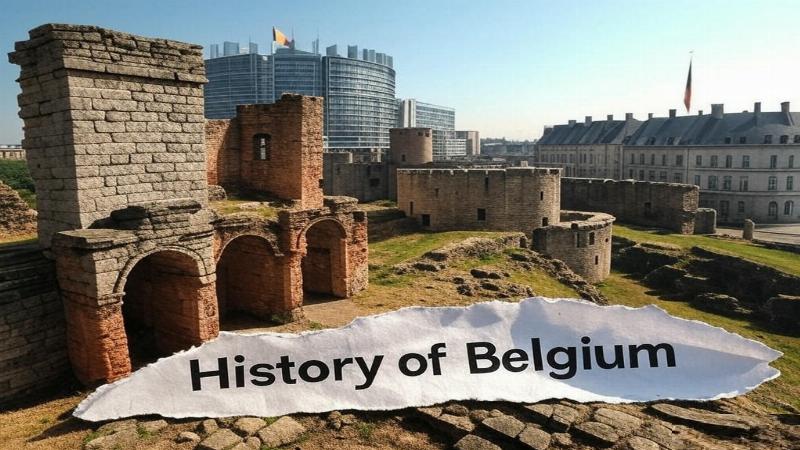Place for ads

Belgium, a small yet pivotal nation in Western Europe, is a land where history unfolds across its rolling plains and bustling cities. Covering 30,548 square kilometers, it sits between France, Germany, the Netherlands, and Luxembourg, its strategic position shaping its fate. Known today for chocolate, waffles, and the European Union’s heart in Brussels, Belgium’s past is a rich blend of ancient tribes, feudal splendor, and modern resilience. In this article, we’ll trace Belgium’s journey from its earliest days to its contemporary role, exploring the milestones that have forged this complex nation.
Belgium’s story begins in the Paleolithic era, around 250,000 BCE, with Neanderthals leaving tools in caves like Scladina near Namur. By 30,000 BCE, modern humans arrived, crafting flint and hunting mammoths—remains at Spy Cave attest to this. The Neolithic period (circa 4500 BCE) brought farming, with settlements along the Meuse River growing wheat and barley.
The Bronze Age (2000 BCE) saw the Bell Beaker culture, known for its pottery, while the Iron Age (500 BCE) introduced Celtic tribes—the Belgae. Julius Caesar described them as “the bravest of all Gauls” in his Gallic Wars, their resistance foreshadowing Belgium’s enduring spirit.
In 57
Place for ads
Rome’s fall in the 5th century CE left Belgium fragmented. Germanic Franks moved in, with King Clovis I uniting them by 486 CE. Christianity spread—St. Servatius evangelized Tongeren—blending Roman and Frankish cultures into the Merovingian and Carolingian eras.
By the 9th century, Belgium split between the Frankish kingdoms. The Treaty of Verdun (843) divided Charlemagne’s empire—Flanders in the west fell to France, Brabant and Hainaut in the east to the Holy Roman Empire. Cities like Bruges, Ghent, and Antwerp rose as trade hubs in Flanders, their wool and cloth weaving medieval Europe’s economy.
The 11th-century Counts of Flanders, like Baldwin V, built power, while the Duchy of Brabant emerged around Brussels. Castles—like Gravensteen—dotted the land, but the 1302 Battle of the Golden Spurs saw Flemish peasants crush French knights, a rare triumph of commoners. By the 15th century, the Burgundian dukes united most of Belgium, ushering in a cultural bloom.
In 1477, Mary of Burgundy’s marriage to Maximilian Habsburg brought Belgium under Habsburg rule. Her son, Philip the Handsome, and grandson, Charles V—born in Ghent in 1500—expanded this dominion. Charles, Holy Roman Emperor, ruled a vast empire from Brussels, making it a Renaissance hub of art and politics.
The 16th-century Reformation split Belgium. Protestantism spread in the north, but Spain’s Philip II—Charles’ successor—imposed Catholicism, sparking the 1566 Iconoclastic Fury. The Eighty Years’ War erupted, and the 1585 fall of Antwerp divided the Low Countries—Belgium stayed Spanish, while the Netherlands broke free.
The Spanish Netherlands (1585–1713) saw war and decline—Bruges faded, Antwerp rebuilt. The 1648 Peace of Westphalia ended religious strife but weakened Spain. The 1713 Treaty of Utrecht handed Belgium to Austria’s Habsburgs, renaming it the Austrian Netherlands. Empress Maria Theresa (1740–1780) brought stability, rebuilding Brussels’ Grand Place.
Reform met resistance—Joseph II’s 1780s edicts sparked the Brabant Revolution, a short-lived republic crushed by 1790. Napoleon’s 1794 invasion annexed Belgium to France, modernizing law and infrastructure until his 1815 defeat at Waterloo—fought on Belgian soil—returned it to new hands.
The 1815 Congress of Vienna merged Belgium with the Netherlands under King William I. This union chafed—Dutch Protestants dominated, sidelining French-speaking Catholic Belgians. Economic woes and cultural divides fueled unrest, erupting in the 1830 Belgian Revolution. Opera-goers in Brussels sparked riots, driving Dutch troops out.
By 1831, Belgium declared independence, crowning Leopold I—German prince, British uncle—as king. The Treaty of London guaranteed neutrality, a promise tested by later wars. Belgium industrialized—coal, steel, and railways boomed—while colonial wealth from Leopold II’s brutal Congo Free State (1885–1908) stained its prosperity.
World War I shattered Belgium’s neutrality. Germany invaded in 1914, sparking the Rape of Belgium—thousands died, cities like Leuven burned. King Albert I led resistance from Ypres’ trenches, holding a sliver of land. The 1918 armistice freed Belgium, its bravery earning reparations.
World War II struck in 1940—Germany overran Belgium in 18 days. King Leopold III surrendered, sparking controversy; he stayed under occupation while the government fled to London. The 1944 Battle of the Bulge ravaged Ardennes, but liberation came. Post-war, Leopold abdicated in 1951 for Baudouin, ending a divisive reign.
Belgium rebuilt with Marshall Plan aid, joining NATO (1949) and the European Coal and Steel Community (1951)—seeds of the EU. Brussels hosted the 1958 World’s Fair, its Atomium a symbol of progress. Industry—chemicals, textiles—thrived, but linguistic tensions grew between Dutch-speaking Flanders and French-speaking Wallonia.
The 1960s saw federalization—language borders split governance. Congo’s 1960 independence ended colonial ties, refocusing Belgium inward. By the 1980s, devolution created Flanders, Wallonia, and Brussels as regions, a compromise to unity amid cultural divides.
Today, Belgium’s 11.5 million people balance diversity—Flemish, Walloon, and a German minority. Brussels, EU and NATO headquarters, is a global hub, its Grand Place a UNESCO gem. The economy blends high-tech with tradition—beer, fries, and Tintin endure. Federalism evolved by 1993, with King Philippe a ceremonial figure since 2013.
Challenges persist—2016 Brussels bombings exposed security gaps, while regional tensions test unity. Climate floods in 2021 hit Wallonia hard, yet Belgium’s role in Europe grows. Culture—Magritte, Breughel—shines, a bridge between past and present.
Belgium’s history is a saga of crossroads—from Roman Gaul to medieval trade, wars to modern peace. Its fields have borne conquests, its cities birthed Europe’s future. As Belgium strides forward, its past weaves a tale of grit and grace at the continent’s heart.
Place for ads